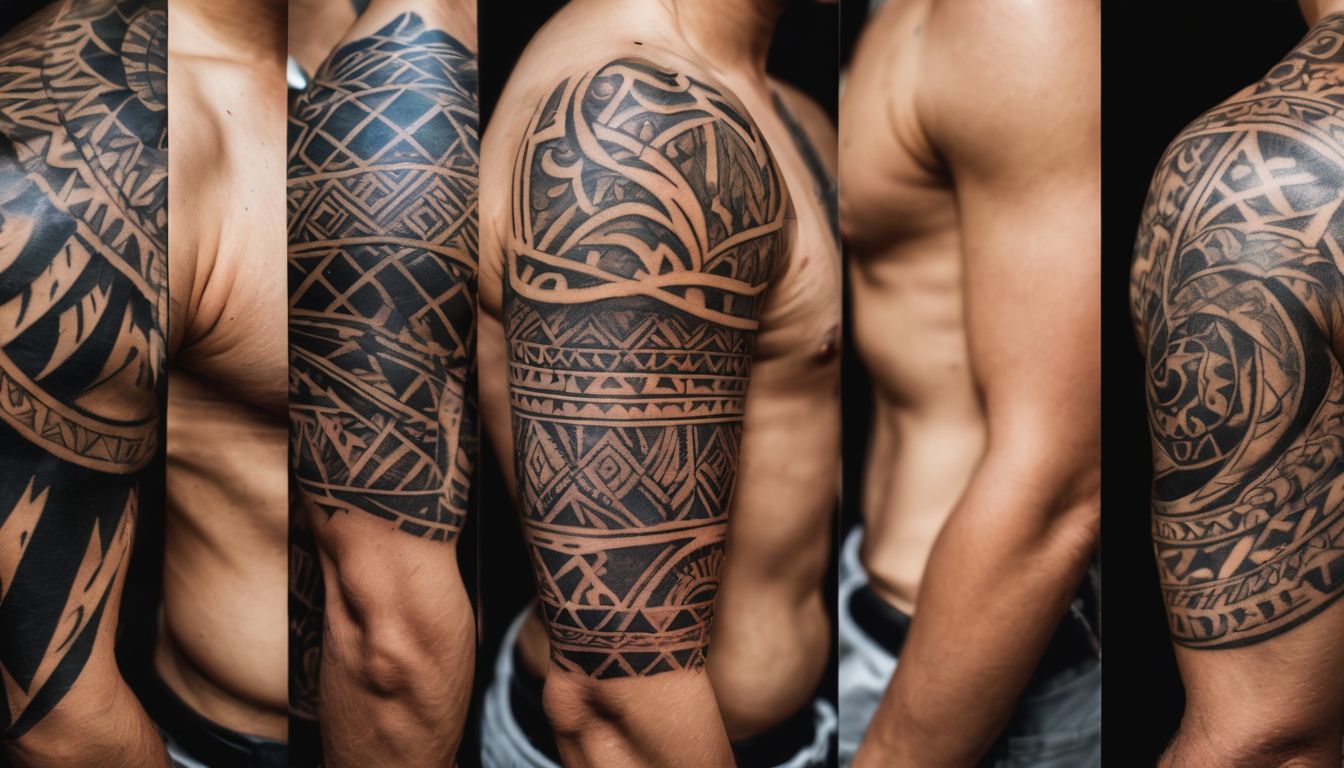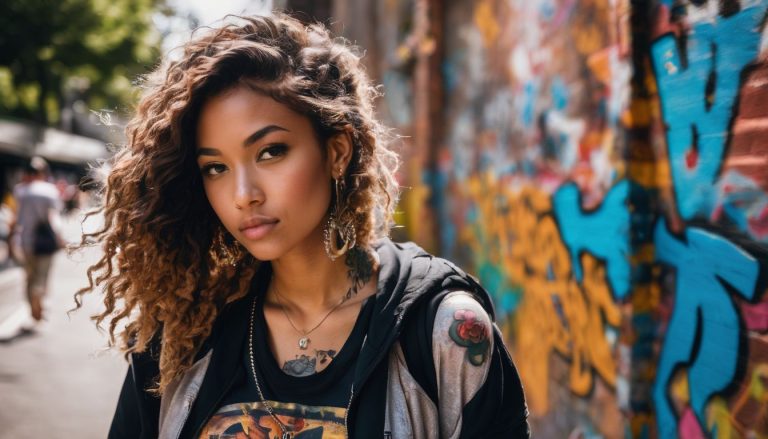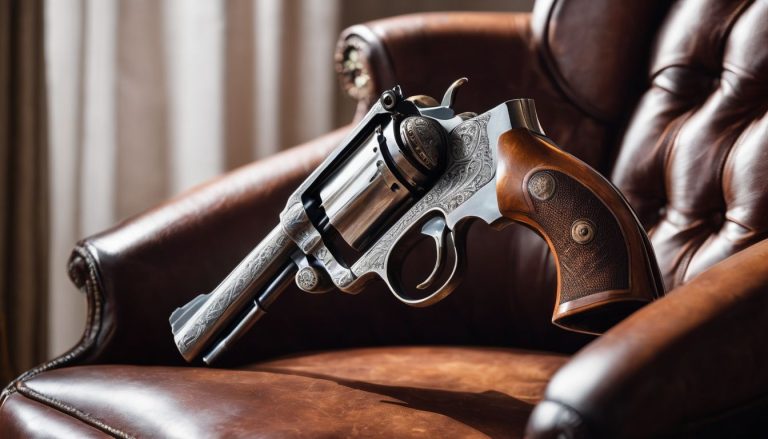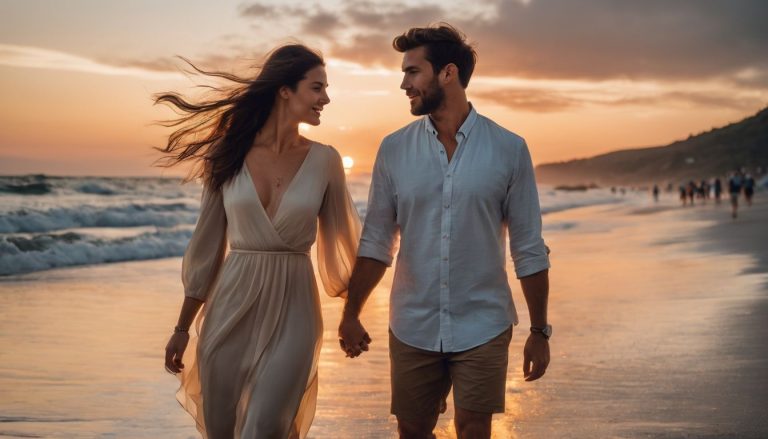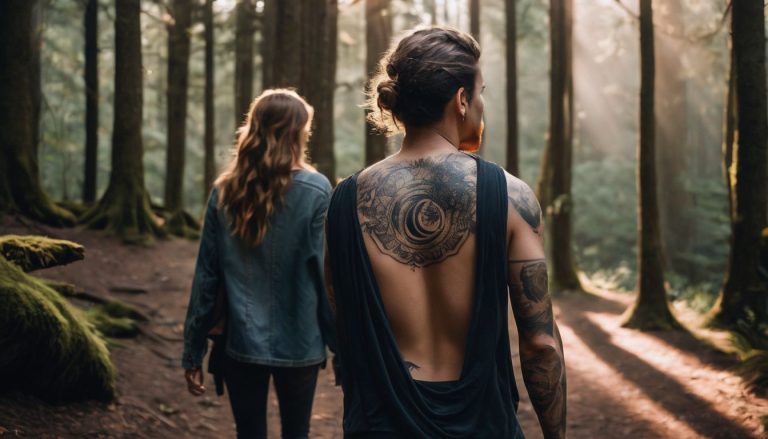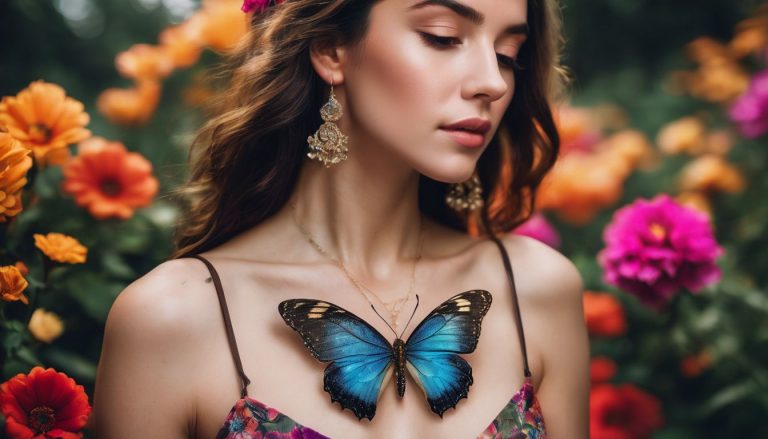Exploring the Meaning Behind Tribal Tattoo Designs
Create your own unique tattoos and art for your home
Many people choose tattoos with cool looks, but don’t know their meanings. Tribal tattoos are steeped in history and serve as more than just body art. This post will guide you through the symbolism behind tribal tattoo designs to help you make an informed choice.
Discover the stories your ink could tell.
Key Takeaways
- Tribal tattoos connect people to ancient cultures, with animals and nature often symbolizing strength, bravery, and spirituality.
- Traditional tribal designs tie deeply to cultural identity and heritage while modern interpretations incorporate personal meanings.
- Placement of tribal tattoos can vary greatly, with popular spots including the upper arm, chest, back, shoulder blade, calf, and more subtle areas like wrists or ankles.
- Common questions about tribal tattoos cover their appropriateness across different cultures, pain levels during tattooing, misconceptions related to their meanings.
- Women’s tribal tattoo designs frequently feature flowers and feathers for a feminine touch; men often opt for symbols that evoke power like wolves or celestial motifs.
What is a Tribal Tattoo?
Tribal tattoos have a rich history and cultural significance, originating from various indigenous communities around the world. These traditional designs have evolved into modern interpretations that still hold deep meaning for those who choose to adorn their bodies with them.
History and origins
Tribal tattoos hold a deep-seated heritage, tracing back to ancient civilizations where they defined identity and social standing. These ancestral tattoo artworks were integral to tribal life, marking significant events like rites of passage or acts of valor.
Indigenous peoples across various continents used these primitive tattoo designs as distinct symbols for their communities. Markings could indicate a person’s rank within the tribe, accomplishments in battle, or spiritual beliefs.
The practice varied from culture to culture; in some traditions, receiving a tattoo was an elaborate ritual imbued with sacred meaning. Polynesian societies are renowned for intricate patterns that symbolize protection and courage – like ocean waves and shark teeth – while Native American tribes favored designs that spoke to natural elements and spiritual guides.
Each design held profound significance tied to the wearer’s lineage or role within the tribe, making every mark a story written on the skin. Modern interpretations may differ in style but looking at them invokes curiosity about their storied pasts steeped in cultural richness.
Traditional vs modern tribal designs
Having explored the rich history and origins of tribal tattoo designs, it’s intriguing to compare traditional patterns with their modern counterparts. Traditional tribal designs are deeply rooted in indigenous cultures, reflecting symbols of social status, familial ties, and cultural philosophies.
These timeless motifs hold significant meaning within each culture, often representing power, fertility, freedom, and bravery. On the other hand, modern tribal designs have evolved to incorporate contemporary interpretations and personal expressions while still honoring the cultural significance behind these tattoos.
In contrast to traditional styles that adhere closely to ancestral symbolism and meanings, modern tribal designs may include diverse elements influenced by individual creativity and contemporary aesthetics.
Different Meanings Behind Tribal Tattoo Designs
Exploring the significance of tribal tattoo designs and their representations of animals, nature, strength, bravery, and cultural identity. Understanding the deeper meanings behind traditional and modern tribal tattoo designs.
Representations of animals and nature
Tribal tattoo designs often incorporate animals and nature as significant symbols. Animals such as wolves, lions, and dragons are commonly featured in tribal tattoos for their association with strength, courage, and power.
Nature elements like trees, flowers, and waves can also be incorporated to symbolize life, growth, and resilience. In many indigenous cultures, these representations hold deep spiritual and symbolic meaning reflecting the connection between humans and the natural world.
Understanding the significance of these animal and nature motifs is crucial for those considering a tribal tattoo design that aligns with their personal values.
Animals have long been revered in tribal cultures for their characteristics which represent important virtues within communities. From the roaring lion signifying bravery to the wise owl representing knowledge and wisdom; animals play a vital role in conveying powerful messages through tribal tattoos.
Symbols of strength and bravery
Tribal tattoo designs often incorporate symbols of strength and bravery, such as animals like the lion, bear, or eagle. These creatures are revered for their power and fearlessness in many tribal cultures.
Additionally, specific geometric patterns and shapes can also represent courage and resilience within a community. Understanding these symbolic representations is crucial for individuals considering getting a tribal tattoo as it allows them to connect with the rich history and cultural significance behind these designs.
The concept of bravery in tribal tattoos goes beyond physical strength; it encompasses mental fortitude and spiritual courage too. Many traditional tribal designs reflect not only an individual’s might but also their ability to persevere through adversity, making them powerful symbols of inner strength.
Cultural significance and identity
Tribal tattoo designs carry deep cultural significance and are often closely tied to the identity of the wearer. These traditional tattoo patterns symbolize important aspects within the tribal community, such as social status, familial ties, and philosophies.
In ancient cultures, these tattoos served as a distinguishing mark between tribes and were also seen as a rite of passage and a display of bravery. Each element incorporated in tribal tattoos holds specific meaning for the tribe’s heritage and traditions, reflecting power, fertility, freedom, or other significant values within their culture.
The cultural identity embedded in tribal tattoo designs plays a crucial role in preserving ancestral traditions while also serving as visual representations of historical narratives.
Popular Tribal Tattoo Designs for Men
Men often choose tribal tattoo designs that represent strength and power, such as wolves, lions, dragons, and other powerful animals. Celestial symbols like the sun and moon are also popular choices for men’s tribal tattoos.
Wolf, lion, dragon, and other animal motifs
Tribal tattoos featuring wolf, lion, and dragon motifs symbolize strength and power. In ancient cultures, these animal designs were seen as representations of bravery and courage. The wolf was associated with loyalty and ferocity in battle, while the lion signified leadership and fearlessness.
Dragons held symbolic importance as protectors and bringers of fortune.
These animal motifs continue to be popular choices for tribal tattoos due to their deep historical significance and association with noble qualities. The intricate patterns of these designs add a bold statement to the wearer’s identity, conveying a sense of resilience and authority.
Sun, moon, and other celestial symbols
Celestial symbols like the sun and moon hold significant meaning in tribal tattoo designs. The sun often symbolizes life, power, and leadership, while the moon represents femininity, mystery, and cycles of life.
These celestial motifs are often incorporated into tribal tattoos to signify strength, guidance, and a connection to nature. In various cultures, the sun and moon have been revered as divine entities that influence daily life and spiritual beliefs.
The inclusion of celestial symbols in tribal tattoos serves as a powerful representation of ancient wisdom and an individual’s connection to the cosmos. These timeless symbols convey profound meanings beyond their visual appeal – they reflect elements of spirituality, balance, and personal growth within indigenous communities.
Popular Tribal Tattoo Designs for Women
– Women often choose tribal tattoo designs that incorporate feminine elements such as flowers, feathers, and intricate patterns with personal meanings. These designs are typically placed on more delicate areas of the body such as the wrist, ankle, or lower back.
Flowers, feathers, and other feminine designs
Flowers, feathers, and other feminine designs are popular choices for women’s tribal tattoos. These symbols often represent beauty, grace, and spirituality in various cultures and traditions.
For example, the lotus flower is commonly featured in tribal designs as a symbol of purity and enlightenment. Feathers can also hold deep meaning as symbols of freedom or spiritual connection.
Women who choose these designs may be seeking to express their individuality and inner strength.
When considering a tribal tattoo with feminine elements, it’s important to research the specific cultural significance behind each design to ensure an accurate representation of its meanings.
Tribal patterns with personal meanings
Tribal patterns, such as Maori and Polynesian designs, often hold deeply personal significance for those who wear them. These traditional tattoo motifs are not just decorative; they carry stories of cultural identity, ancestral heritage, and individual experiences.
For instance, a Polynesian pattern may represent the wearer’s journey or significant life events, while a Maori design could denote their connection to specific tribal roots and family lineage.
Incorporating personal meanings into these iconic tribal patterns is a way for individuals to honor their past, express their values, and showcase their unique narrative through body art.
Placement and FAQs
Tribal tattoos are commonly placed on the upper arm, chest, back, and shoulder. Some people also choose to have them on their legs or even hands. Common questions include concerns about pain levels and whether tribal tattoos hold any taboo meanings in certain cultures.
Recommended placements for tribal tattoos
Recommended placements for tribal tattoos vary depending on the design and personal preference. When choosing a placement, consider the significance of the tattoo and how it complements your body’s natural lines and shapes. Here are some popular areas for tribal tattoos:
- Upper arm: Tribal designs can wrap around the upper arm, emphasizing its strength and flexibility. This placement is ideal for showcasing intricate patterns or symbolic motifs.
- Calf: The calf provides a large canvas for bold tribal designs, often representing power and endurance. It’s a prominent location that allows for eye-catching artwork.
- Shoulder blade: Tribal tattoos on the shoulder blade exude confidence and courage. The expansive space allows for elaborate designs that make a bold statement.
- Chest: Placing a tribal tattoo on the chest symbolizes protection and strength. Intricate patterns can be adapted to accentuate the contours of the chest area.
- Back: A tribal tattoo on the back signifies resilience and resilience in various cultures. Its broad canvas offers ample room for complex designs with deep cultural meanings.
- Forearm: Tribal tattoos on the forearm showcase determination and purpose, making them well-suited for bold symbols or meaningful patterns.
- Thigh: The thigh provides ample space for larger tribal designs, often symbolizing vitality and empowerment. This placement allows for striking visuals with significant cultural symbolism.
- Wrist or hand: Smaller tribal tattoos on the wrist or hand can represent unity or interconnectedness within communities, offering subtle yet meaningful symbolism in daily life.
- Ankle or foot: Placing a tribal tattoo on the ankle or foot carries meanings of connection to nature, movement, and adaptability, with designs often reflecting these themes in intricate patterns.
Common questions and misconceptions
Common questions and misconceptions about tribal tattoos often arise due to their cultural significance and varied symbolism. Here are some important points to consider:
- Some people wonder if it’s appropriate to get a tribal tattoo if they do not belong to the specific culture it represents. While it’s important to respect the cultural origins of tribal tattoos, it’s also possible to appreciate and honor them without appropriation.
- Many individuals are concerned about the permanence of a tribal tattoo and what it means for their identity over time. It’s important to carefully consider the meaning behind the design and ensure its significance will endure.
- There is often confusion surrounding the distinction between traditional and modern tribal designs, with many assuming they hold similar meanings. However, modern interpretations may have evolved from original cultural symbolism.
- People commonly ask about the pain level associated with getting a tribal tattoo, as well as its potential impact on everyday activities during the healing process.
- Misconceptions can also revolve around the idea that all tribal tattoos represent aggressive or warrior-like traits, when in fact they encompass a wide range of meanings beyond strength and bravery.
Conclusion
In conclusion, tribal tattoo designs hold immense cultural significance. Understanding the meanings behind these ancient symbols is crucial for those considering getting a tribal tattoo.
Symbols representing strength, bravery, and identity have been preserved through traditional and modern tribal designs. Appreciating the rich history and symbolism of tribal tattoos can add depth to one’s personal body art choices.
FAQs
1. What are tribal tattoo designs and what do they represent?
Tribal tattoo designs are patterns that come from ancient tribal markings and symbolize cultural and ethnic heritage, often reflecting traditional symbols, rituals, and ancestral traditions.
2. Can you explain the significance of indigenous tattoo patterns?
Indigenous tattoo patterns hold deep meanings related to the beliefs and stories of native cultures; these tattoos can signify a person’s status, identity, or connection to their community.
3. How do Polynesian tattoo symbolism differ from Native American designs?
Polynesian tattoo symbolism is known for its intricate geometric patterns which often represent social rank and spiritual beliefs while Native American designs frequently depict natural elements like animals or landscapes conveying specific teachings or histories.
4. Are there common themes found in different cultural tattoo symbols?
Yes, many cultural tattoo symbols across various tribes share common themes such as strength, wisdom, unity with nature — each designed uniquely to reflect their own ethnic motifs and traditional values.
5. Why is it important to understand the history behind tribal body art before getting one?
Understanding the history behind tribal body art ensures respect for the ancient symbolic meanings that these tattoos carry; it’s about honoring the ritualistic significance tied to these cultural expressions.

